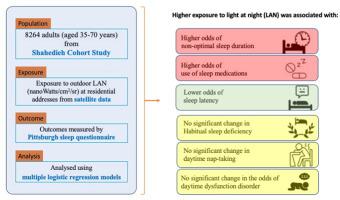Shahedieh队列研究中夜间暴露于室外光线与睡眠习惯的关系:一项横断面分析
IF 7.3
2区 环境科学与生态学
Q1 ENVIRONMENTAL SCIENCES
引用次数: 0
摘要
人们认为,在住宅环境中夜间暴露于光线与一系列健康结果有关,包括睡眠问题。然而,现有的证据仍然很少。该研究基于居住在伊朗亚兹德省的8284名成年人(35-70岁)的数据,并参与了Shahedieh队列研究的招募阶段(2015-2017年)。通过面对面访谈收集睡眠相关结果和协变量。通过卫星数据测量了住宅地址在不同暴露窗口的室外局域网暴露(纳瓦/平方厘米/锶)。使用调整了相关变量的逻辑回归模型(以比值比[OR]和95%置信区间[CI]报道,每四分位数范围[IQR]增加LAN)来检验LAN与睡眠习惯的关联。室外局域辐射范围为0.54 ~ 69.27 nanoWatts/cm2/sr (IQR: 14.91)。暴露于室外LAN与较短的睡眠时间(OR: 1.21; 95% CI: 1.10-1.32)和使用睡眠药物(OR: 1.29; 95% CI: 1.08-1.53)之间存在显著关联。相比之下,更大的局域网暴露与较低的睡眠潜伏期延长的可能性有关。在女性(例如,男性使用睡眠药物OR: 1.19; 95% CI: 0.91-1.55,而女性OR: 1.40; 95% CI: 1.11-1.77)、失业和超重/肥胖参与者中,相关性更强。考虑到城市地区暴露人群的比例较大以及正在进行的城市化,室外局域网可视为对公共卫生的日益严重的威胁。本文章由计算机程序翻译,如有差异,请以英文原文为准。

Association between Exposure to Outdoor Light at Night and Sleep Habits in Shahedieh Cohort Study: A Cross-sectional Analysis
Exposure to light at night (LAN) in residential environments has been suggested to be associated with a range of health outcomes, including sleep problems. Yet, the available evidence remains scarce. The study was based on data from 8,284 adults (aged 35-70 years) residing in Yazd province, Iran, and participating in the Shahedieh Cohort Study enrolment phase (2015-2017). Sleep-related outcomes and covariates were collected through face-to-face interviews. Exposure to outdoor LAN (nanoWatts/cm2/sr) at different exposure windows was measured at residential addresses via satellite data. The association of LAN with sleep habits was tested using logistic regression models adjusted for relevant variables (reported as odds ratio [OR], and 95% confidence intervals [CI], per interquartile range [IQR] increase of LAN). The outdoor LAN was in the range of 0.54 to 69.27 nanoWatts/cm2/sr (IQR: 14.91). A significant association was found between exposure to outdoor LAN and shorter sleep duration (OR: 1.21; 95% CI: 1.10-1.32), and use of sleep medications (OR: 1.29; 95% CI: 1.08-1.53). In contrast, greater LAN exposure was associated with lower odds for prolonged sleep latency. Associations were mostly stronger in women (e.g., use of sleep medications in men OR: 1.19; 95% CI: 0.91-1.55 compared to women OR: 1.40; 95% CI: 1.11-1.77), non-employed, and overweight/obese participants. Considering the large proportion of the exposed population in urban areas and the ongoing urbanization, outdoor LAN can be regarded as an increasing threat for public health.
求助全文
通过发布文献求助,成功后即可免费获取论文全文。
去求助
来源期刊

Environmental Pollution
环境科学-环境科学
CiteScore
16.00
自引率
6.70%
发文量
2082
审稿时长
2.9 months
期刊介绍:
Environmental Pollution is an international peer-reviewed journal that publishes high-quality research papers and review articles covering all aspects of environmental pollution and its impacts on ecosystems and human health.
Subject areas include, but are not limited to:
• Sources and occurrences of pollutants that are clearly defined and measured in environmental compartments, food and food-related items, and human bodies;
• Interlinks between contaminant exposure and biological, ecological, and human health effects, including those of climate change;
• Contaminants of emerging concerns (including but not limited to antibiotic resistant microorganisms or genes, microplastics/nanoplastics, electronic wastes, light, and noise) and/or their biological, ecological, or human health effects;
• Laboratory and field studies on the remediation/mitigation of environmental pollution via new techniques and with clear links to biological, ecological, or human health effects;
• Modeling of pollution processes, patterns, or trends that is of clear environmental and/or human health interest;
• New techniques that measure and examine environmental occurrences, transport, behavior, and effects of pollutants within the environment or the laboratory, provided that they can be clearly used to address problems within regional or global environmental compartments.
 求助内容:
求助内容: 应助结果提醒方式:
应助结果提醒方式:


